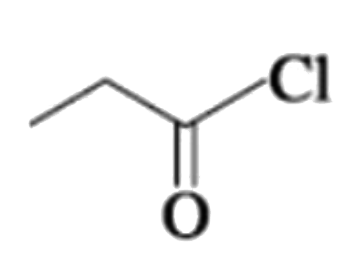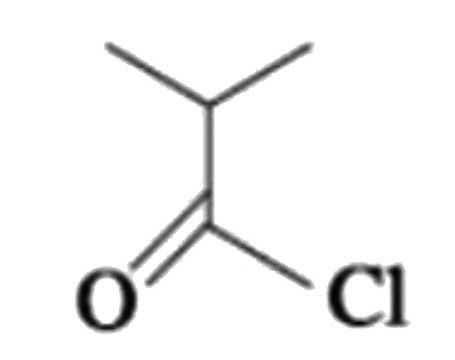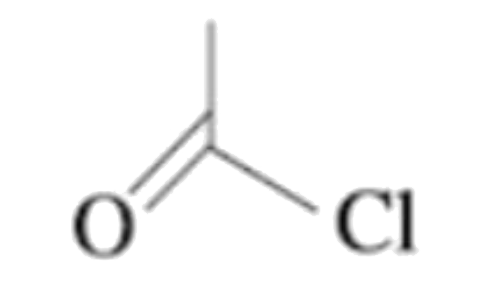C4H7OClNH3−−→C4H9ONBr2−−→KOHCH3CH2CH2NH2 Compound (X) is




The correct Answer is:C
To determine the initial compound (X) in the reaction sequence given, we can break down the process step by step.
Step 1: Identify the Final Product
The final product given is CH₃CH₂CH₂NH₂, which is a primary amine. This suggests that the compound before the final step was likely an amide, as the reaction involves the Hofmann bromamide reaction.
Step 2: Determine the Amide Structure
The Hofmann bromamide reaction converts an amide to a primary amine. Therefore, we can deduce that the compound before the addition of Br₂ and KOH was an amide. The structure of the amine CH₃CH₂CH₂NH₂ indicates that the corresponding amide would be CH₃CH₂CH₂C(O)NH₂.
Step 3: Identify the Preceding Compound
The compound that reacts with NH₃ to form the amide must be an acyl chloride (since acyl chlorides react with ammonia to form amides). The acyl chloride corresponding to the amide CH₃CH₂CH₂C(O)NH₂ would be CH₃CH₂CH₂C(O)Cl.
Step 4: Write the Structure of Compound (X)
Thus, the initial compound (X) must be CH₃CH₂CH₂C(O)Cl, which can be represented as C₄H₇OCl. This matches the molecular formula given in the question.
Conclusion
Therefore, the initial compound (X) is butanoyl chloride (C₄H₇OCl).
Summary of Steps:
1. Identify the final product as a primary amine.
2. Determine that the compound before the final step was an amide.
3. Identify the acyl chloride that reacts with NH₃ to form the amide.
4. Conclude that the initial compound (X) is butanoyl chloride.
The final product given is CH₃CH₂CH₂NH₂, which is a primary amine. This suggests that the compound before the final step was likely an amide, as the reaction involves the Hofmann bromamide reaction.
The Hofmann bromamide reaction converts an amide to a primary amine. Therefore, we can deduce that the compound before the addition of Br₂ and KOH was an amide. The structure of the amine CH₃CH₂CH₂NH₂ indicates that the corresponding amide would be CH₃CH₂CH₂C(O)NH₂.
The compound that reacts with NH₃ to form the amide must be an acyl chloride (since acyl chlorides react with ammonia to form amides). The acyl chloride corresponding to the amide CH₃CH₂CH₂C(O)NH₂ would be CH₃CH₂CH₂C(O)Cl.
Thus, the initial compound (X) must be CH₃CH₂CH₂C(O)Cl, which can be represented as C₄H₇OCl. This matches the molecular formula given in the question.
Therefore, the initial compound (X) is butanoyl chloride (C₄H₇OCl).
1. Identify the final product as a primary amine.
2. Determine that the compound before the final step was an amide.
3. Identify the acyl chloride that reacts with NH₃ to form the amide.
4. Conclude that the initial compound (X) is butanoyl chloride.
Similar Questions
Knowledge Check
(A)NH3−−→(B)KOH/Br2−−−−−−→(CH3)2CHNH2 A is
A B
B C
C D
D
When carboxylic acid reacts with organolithium reagents to give ketones, side reaction sometines occur. For example,
HOCH2CH2CH3∣CHCH2CH2O∣∣COH(x)CH3Li−−−−−−−−−→tetrahydro furanNH4Cl−−−→H2HOCH2CH2CH3∣CHCH2CH2−O∣∣CCompound A 63%−CH3+Compound (B)37%
Value of (x) in above reaction is :A2B3C4D5Rank the transition states that occur during the following reaction steps in order of increasing stability (least → most stable) :
1. H3C−+OH2→CH+3+H2O
2. (CH3)3C−+CH2→(CH3)3C++H2O
3. (CH3)2CH−+OH2→(CH3)2CH++H2OA1<2<3B2<3<1C1<3<2D2<1<3
Which of the following reactions will yield propan-2-ol ? Select the right answer from (a), (b), (c) and (d)
I. CH2=CH−CH3+H2OH+−−→
II. CH3−CHOCH3MgI/H2O−−−−−−−−→
III. CH2OC2H5MgI−−−−−−−−→H2O
IV. CH2=CH−CH3Neutral KMnO4−−−−−−−−−−→
View SolutionWrite the IUPAC names of the following compounds
(i) CH3−CH2−O∣∣C−CH2−O∣∣C−CH3
(ii) CH3−O∣∣C−CH2−CH2−CH2−CH2−COOH
(iii) CH3−CH∣C2H5−CH∣C2H5−CH3
View SolutionIn the given reaction
CH2−CH2−O∣∣C−CH2COOC2H5[X]−−→(A)(i)LiAlH4−−−−−−−−→(ii)H2O/H⊕CH3−CH2−O∣∣C−CH2−CH2OH+C2H5OH
[X] will be
View SolutionCH3−CH3∣CH−NO2NaNO2+H2SO4−−−−−−−−−−−−→at0∘C(A). (A) is:
View SolutionThe correct IUPAC name of the following compound is :
CH3CH2−C∣CH3H−CH=C∣C2H5−C2H5∣CH−CH2−CH2−CH2−CH3
View Solution
